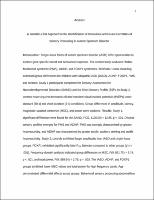Please use this identifier to cite or link to this item:
https://hdl.handle.net/20.500.12202/5800Full metadata record
| DC Field | Value | Language |
|---|---|---|
| dc.contributor.advisor | Zemon, Vance | |
| dc.contributor.advisor | Siper, Paige | |
| dc.contributor.advisor | Gordon, James | |
| dc.contributor.author | Lurie, Stacey | |
| dc.date.accessioned | 2020-07-14T17:23:53Z | |
| dc.date.available | 2020-07-14T17:23:53Z | |
| dc.date.issued | 2020-01 | |
| dc.identifier.citation | Lurie, Stacey.(2020) A Genetics-First Approach to the Identification of Behavioral and Neural Correlates of Sensory Processing in Autism Spectrum Disorder. [Unpublished doctoral dissertation, Yeshiva University] | en_US |
| dc.identifier.uri | https://hdl.handle.net/20.500.12202/5800 | |
| dc.description | Doctoral dissertation, Ph.D. Clinical Psychology. Ferkauf Graduate School of Psychology -- Open Access. | en_US |
| dc.description.abstract | Introduction: Single-locus forms of autism spectrum disorder (ASD) offer opportunities to explore gene-specific neural and behavioral responses. The current study evaluates Phelan- McDermid syndrome (PMS), ADNP, and FOXP1 syndromes. Methods: Linear modeling examined group differences for children with idiopathic ASD (iASD), ADNP, FOXP1, PMS, and controls. Study 1 participants completed the Sensory Assessment for Neurodevelopmental Disorders (SAND) and the Short Sensory Profile (SSP). In Study 2, contrast-reversing checkerboards elicited transient visual evoked potentials (tVEPs) under standard (60-s) and short-duration (2-s) conditions. Group differences in amplitude, latency, magnitude-squared coherence (MSC), and power were explored. Results: Study 1, significant differences were found for the SAND, F(32, 1120.00) = 12.85, p < .001. Distinct sensory profiles emerged for PMS and ADNP: PMS was strongly characterized by greater hyporeactivity, and ADNP was characterized by greater tactile, auditory seeking and tactile hyporeactivity. Study 2, controls exhibited larger amplitudes than iASD and single-locus groups. FOXP1 exhibited significantly later P100 latencies compared to other groups (p’s < .001). Frequency-domain analysis indicated group differences in MSC, F(9, 891.75) = 9.74, p < .001, and total power, F(9, 889.54) = 2.79, p = .003. The iASD, ADNP, and FOXP1 groups exhibited lower MSC values and total power for high frequency bands. Age demonstrated differential effects across groups. Behavioral sensory processing abnormalities correlated with weaker tVEPs. Conclusions: Distinct sensory phenotypes in PMS and ADNP and impaired glutamatergic signaling in iASD/single-locus cases were found, as were relationships between behavioral and electrophysiological measures. VEPs may yield objective, clinically-meaningful biomarkers of ASD. | en_US |
| dc.language.iso | en_US | en_US |
| dc.rights | Attribution-NonCommercial-NoDerivs 3.0 United States | * |
| dc.rights.uri | http://creativecommons.org/licenses/by-nc-nd/3.0/us/ | * |
| dc.subject | Autism Spectrum Disorder (ASD) | en_US |
| dc.subject | Sensory Processing | en_US |
| dc.subject | FOXP1 syndrome | en_US |
| dc.subject | Phelan-McDermid syndrome | en_US |
| dc.subject | ADNP syndrome | en_US |
| dc.subject | Visual Evoked Potentials | en_US |
| dc.title | A Genetics-First Approach to the Identification of Behavioral and Neural Correlates of Sensory Processing in Autism Spectrum Disorder | en_US |
| dc.type | Dissertation | en_US |
| Appears in Collections: | Ferkauf Graduate School of Psychology: Doctoral Dissertations | |
Files in This Item:
| File | Description | Size | Format | |
|---|---|---|---|---|
| Lurie Dissertation Draft 3.10.20_clean.pdf | 3.53 MB | Adobe PDF |  View/Open |
This item is licensed under a Creative Commons License

